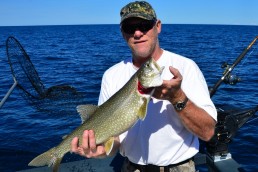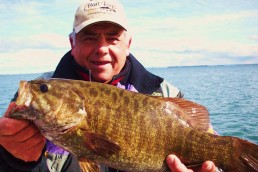SHARE THIS POST
In the early 1950s, when I first began trips to Grand Marais, Mich., trout fishing in Lake Superior was one of the main attractions and dozens of charter captains fished for lakers. My family would visit the landing as the boats returned to display the fish caught. I was a boy, so I had no way to charter a trip. But I eyed the huge fish and envied those who caught them.
As many know with the introduction of the lamprey eel in the late ‘30s, lake trout fishing in Superior suffered. By the ‘50s, the lamprey was taking its toll on Lake Superior’s trout, and with it the decline of Grand Marais. By the ‘70s, the small town had taken a turn for the worse.
For those of a literary bent, the descriptions of Grand Marais in the novels of Jim Harrison, for example, in True North and Returning to Earth, are right on the spot. When I first read those works I thought to myself, Damn, I wish I could write like that—capture the essence of a place so well.
But Grand Marais has come back, and Dennis Weaver has been a key figure in its rebirth. Dennis is a retired Marine Corps officer and opened Grand Marais Outfitters on the main corner in town where he caters to hikers, campers, anglers and hunters. Shortly after he opened his business a few years ago, I went in and introduced myself. In the intervening years, Dennis and I have stayed in touch.
But Weaver knows could not have done it without the lake trout.
A few days ago I went into the shop to say hello.
Dennis said, “Let’s go fishing,” as he fiddled with his computer. “Weather’s nice on Thursday. We’ll go lake trout fishing.”
We rendezvoused at the Grand Marais Marina around noon. Shane Buggs and Dale Ross joined us too. Dennis took us several miles to a shoal off the Grand Sable Dunes.
Later, when Dennis gave us the signal, Dale and Shane rigged up and began to fish. We had been over 400 feet of water and came upon a shoal roughly 200 feet deep.
“We’re going to maintain speed at close to 1.8 mph,” Dennis directed.
Experience shows—and that was the optimal speed.
To do that you need a depth finder that records not only depth, but also speed. Dennis called out depths frequently, so Shane and Dale could adjust as needed.
“The lakers are close to the bottom,” Dennis said. “We see some suspended fish on the electronics, but they rarely hit.”
Lures were then kept close to the bottom with Cannon Downriggers.
Shortly after we started fishing again, Shane hooked up and landed a nice Lake Superior lake trout.
I took a couple of “grip-and-grin” photos and said, “I can go home now. I’ve got what I needed.”
Are you enjoying this post?
You can be among the first to get the latest info on where to go, what to use and how to use it!
Nobody laughed.
We talked about the colors that seemed to attract lakers.
“Everybody has a favorite,” Dennis said, “but at 200-feet-plus there’s not a lot of light penetration. I suspect it’s a little bit of movement and light flash. I like spoons with a light color and a dark color on the same lure. On the depth finder, we’re looking for some bait—a cluster. Probably herring or stickleback.”
As we dressed our catch, one of the trout had a burbot about 10 inches long in its throat. On the downriggers, Dennis and his buddies then set the release from the cannonball as what they called, “Pretty stiff.” At 200 feet or more of line out, resetting the rig takes significant effort. And if the tension on the release is too slight, every time the spoon hits the bottom, it releases. When it does, the whole system has to be pulled up and reset.
There’s a flip side to that as well: Once a laker hits, the line has to be snapped from the release behind the cannonball. The secret is to point the rod tip at the line coming from the water and jerk hard. It took me several efforts and good coaching from Dale and Shane to get the hang of it. Understand, from my perspective, 15 feet is deep water, and 200-plus is a whole new ballgame.
And the rods were not what I expected.
When Dennis asked me to go I said I left my muskie/pike gear behind.
“I have the rods, “ he said.
My gear would not have been appropriate. The rods were Shakespeare Ugly Stiks at 9 feet with lots of flexibility. And, all reels had counters to measure the line out.
“With the flexible rod, when a strike comes and the line pulls off the cannonball release, there may be lots of slack in the line,” Dale explained. “The big bend in the rod helps take up the slack before you can start reeling in.”
I noticed after the first fish was caught and dropped in the cooler, Dale surreptitiously stuck his hand in the cooler and wiped it on his spoon.
“Dale, I saw you wipe some water from the cooler where the previously caught lake trout were on your spoon,” I said. “You really think that makes a difference?”
Dale is an honest and decent man, saying, “I watched my kid do it and he told me. It’s probably an old wives’ tale.”
Shane owns the grocery store in Grand Marais and Dale works for the Alger County Road Commission. They are strong fishermen and among the entrepreneurs making Grand Marais tick.
Dennis is not a guide, but I queried him.
He said, “Sometimes, when people offer to take me for a boat ride, I show them a waypoint or two.”
MWO
SHARE THIS POST
Did you enjoy this post?
You can be among the first to get the latest info on where to go, what to use and how to use it!
Tim Mead
Tim Mead is an established outdoor writer and photographer with more than 500 credits in state, regional and national magazines. He is an “Excellence in Craft” award winner from both the Outdoor Writers Association of America (of which he is also vice president) and the Southeast Outdoor Press Association (as well as being past president).



